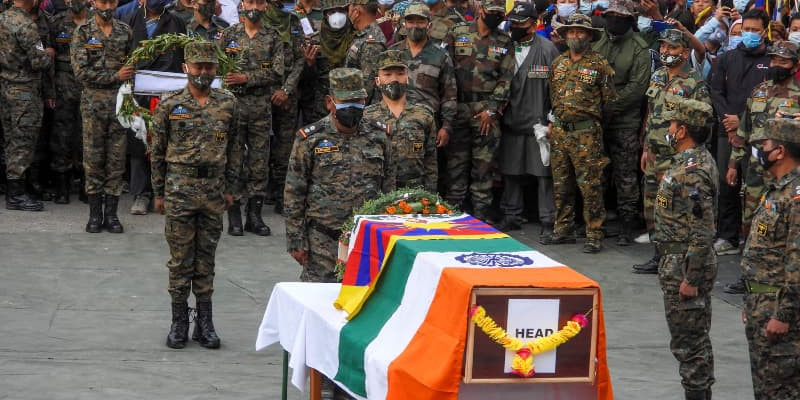By now, we are all aware of the role of Special Frontier Force in the India China standoff along the territory of Ladakh and China occupied Kashmir. In this article, we will try to read between the lines on the contribution of Tibetans, the established capability of SFF and the stance of India and China on the matter.
Why is it relevant for the common people to know?
Since 2014, the Chinese leadership under Xi Jinping has run numerous narratives and initiatives to establish himself as a living legend. He has revised the constitution with “his thoughts” and he has centralized all powers with him. To establish himself as the cause of an unforgettable pride for the Chinese folklore, he has attempted to create a muscular and strong headed China. The current standoffs at the India-Tibet region is an outcome of such approach by Beijing.
On 29th August 2020, units of the Special Frontier Force deployed by the Indian security apparatus occupied highest tactical heights in the recent areas of standoff near Pangong Tso Lake. As prolifically highlighted by the Indian news media Magar Hill, Gurung Hill and Rechin La. The reader shall note that these named heights are at an average altitude of 18000 ft. However, in this operation the unit lost Company Leader/ Political Leader Nyima Tenzin during the operation due to landmine explosion. The irony being that the landmine was planted during the 1962 conflict between India and China. The loss of a SFF company leader has raised a narrative and a counter narrative on the capabilities of the unit and on the larger game in play here.
Why the Special Frontier Force (SFF)?
The Indian security apparatus involves multiple organizations enabling multiple domains of national security. The Special Frontier Force represents the non-conventional and non-military arms of the national security apparatus. In the public domain, this force is known to be operational under the Research and Analysis Wing (RAW), the external intelligence agency of India. Any special force is called as such because they are highly trained and are purpose specific. SFF is purposed to operate and shadow the adversary and mould into the adverse environment of Himalayan deserts. Furthermore, the Tibetans have a natural bearing and physicality making them natural to sync with the tactical attributes of the Chinese, their mode of communication and enabling a better understanding of the adversary.
The tactical advantage:
SFF is trained to operate and conduct clandestine operations along regions of their expertise. It is a rare unit, wherein the local populace of the region living in exile have volunteered to represent their land and are trained to operate at heights of 14000 feet and above. The SFF operatives better understand the physical topography of Ladakh and bordering Tibet region and they also specialize in conducting surveillance and are able to stand guard from the current strongholds at 15000-19000 feet.
The strategic narrative:
What it means to the Tibetans?
Tibet is the erstwhile region neighboring to Ladakh and then onwards stretching to the entire international border and the Line of Actual Control. As the kingdom of Tibet was annexed by China in 1951, there has been no direct representation of Tibetans fighting the Chinese in an organized fashion. Since the annexation of Tibet, the Tibetans and their revered God The 14th Dalai Lama took refuge and freedom to sustain their community in India. Till date, there has been no evidence of communal stress caused to Tibetans in India. In the back drop of 1962 war with China, both Tibetans and Indians found a common adversary and these favorable conditions helped establish the SFF, or known among special forces as “Establishment-22” (Two Two). Although, after continued stay in India for prolonged period, the Tibetans living in India are entitled equivalent to an Indian citizen, this community has been able to sustain their Tibetan ancestry. The death of a high-ranking SFF operative highlights the ethos of the trained units as it is the leader of the units who leads the charge in every difficult situation. Furthermore, these units were able to undertake the mission to an altitude nearing 18000 feet where average daily zero and sub-zero temperature. For a person living in Delhi (700 feet above mean sea level) or anywhere from the plains of India, must undergo 3 stages of acclimatization spanning to a duration of 21 days at each stage. It is but obvious that these operatives are well trained to operate amid heavily guarded and contested tactical heights in the region. Such a significant operation undertaken by SFF highlights the capability of the unit and sends a clear message of hope to the Tibetan community. Post news of the SFF martyr, the Tibetan refugee camps is awake with pride and hope for a better representation. Such acknowledgement was long due for the Tibetan community.
What it means to the Chinese decision makers?
The deployment of SFF puts the Chinese decision makers at the peril of choices available with them. The Reader shall also note that these steps taken by the Indian side were pre-emptive in nature. The Chinese who already occupied the Helmet top and Black top also had an intention to occupy other contested tactical heights. So it was basically a race in which the Tibetans won over the Chinese. It is to be noted that the Communist Party of China (CPC) has undertaken initiatives to “sinicise” the Tibetan Buddhism in Tibet Autonomous Region (TAR) or China occupied Tibet. It means the intention is to alter the nature of Buddhism in line with the ethos of CPC and political submission to the party. Such high stakes activity of the Tibetans supports the Tibetan community cause to unite against the communal subjugation and raise their voice in an organized way. After this incident, Global Times, the mouth piece of Chinese politik, tried to defame the SFF citing the units as “irrelevant” and “cannon fodder” for India. This argument does not stand its life because the Tibetans have time and against proven their capabilities by their engagement in India-Pakistan wars of 1971 and 1999. Moreover, in this event the Tibetans outpaced the Chinese attempts to take over these very same heights. An irrelevant unit cannot undertake such operations beating the self-proclaimed superior Chinese forces.
What does India stand to gain from this?
For this event, it is a huge strategic choice made by the Indians, and it has a strategic takeaway for the Tibetan establishment. The reader shall note that Indian security apparatus has alternate capabilities to undertake such mission, nonetheless SFF bring forth their own school of specialization. From the perspective of the Indians, it highlights the continued operational ability to deploy specialized forces and an invisible acknowledgement to the Tibetan cause. It is to be understood that these units are not under the Indian military but are trained and employed under the Union of India. So, they are not to be understood as a proxy unit. The deployment of SFF along such conflict zones does strengthen the narrative of exiled Tibetans and highlights the illegal occupation and self-assertion by the Chinese. They can be understood as a version of the French Legion, giving the Indian capabilities an extension in their outreach and strong hold in these tough geographical terrains. The French legion is built on similar capabilities which mandates non-French nationals from different walks of life to endure and be part of such French armed forces.
The ripples of this decision
It is to be understood that the people of Tibet represent a culture and a nation very distinctive from the idea of “nation of China”. The kingdom was annexed amidst the era of chaos, leading to exodus of the local populace. The harm and sufferings of the Tibetans cannot remain hidden. Enabling SFF at par with their Indian brethren against China has not appeared in the public domain till date. This event has highlighted the capability of a specially enabled para-military force of volunteers mostly drafted from the exiled Tibetan community. This unique event can strengthen the cause and believes of the free Tibet. Furthermore, the modern-day Indian citizen has acknowledged the effort and ability of the community and the SFF.
Conclusion
As the situation develops, both parties met during the Defense ministers’ meet under the sidelines of Shanghai Cooperation Organization (SCO). It is evident that the tactical pre-emptive step undertaken by India has altered the balance of the situation in favor of India. This development is a test of resolve for both sides as China may linger the resolution and disengagement of her forces from the area. Indian forces will have to sustain the supply of resources to these adverse heights and withstand the odds. Our hearts and hope lay with the bereaved family of Cpy Ldr Nyima Tenzin and the brave jawaans standing guard in those inhospitable heights.







Leave a Reply